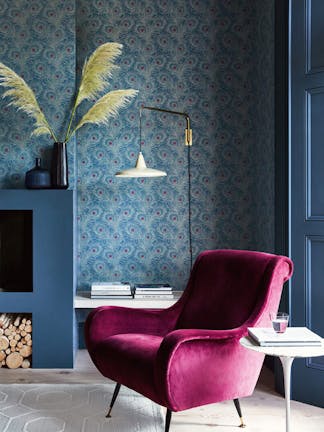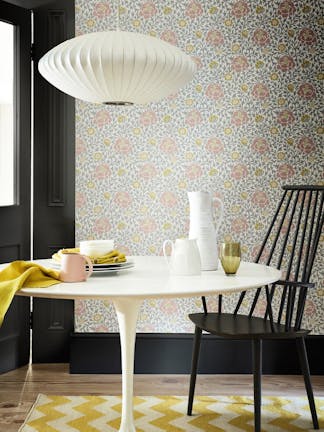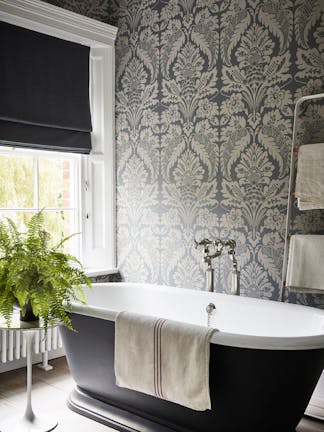
London Wallpapers V

Little Greene presents the 13th wallpaper collection: “London Wallpapers V”. It is a compendium of authentic traditional designs that have been adapted and recolored for use in modern interiors. The collection spans nearly 250 years of interior design, from 1690 to the mid-20th century.
With one exception, the eleven designs in the collection are based on fragments held at the Wallpaper Archive in Wrest Park, Bedfordshire, which were secured and preserved during the restoration of 18th and 19th century London houses. The exception is a first for Little Greene: the original design is still on the walls of Brodsworth Hall, an elegant and faithfully restored Victorian manor house in south Yorkshire.
The oldest archival material for London Wallpapers V actually predates the introduction of wallpaper: it is a decorative piece of leather from 1690 that was part of a hanging (rather than glued to the wall) mural. Other archival documents include hand-printed damask fabrics using the wood panel process, delicate neoclassical
Fragments, hand-stenciled patterns and authentic designs from the Georgian era and the Arts and Crafts period.
London Wallpapers V features four new designs, bringing together best-selling London Wallpapers II and III, complemented by 15 new additional colorways including Hellebore, Acorn, Comet, Carousel, Nordic, Ash, Marle and Gypsum.

Brodsworth - 3 color combinations; circa 1863
A vibrant, captivating design with striking birds and delicate floral motifs. The slightly raised pattern with richly gilded details was intended to imitate the appearance of originally embossed leather. Based on early 18th-century French fabrics and decor, the wallpaper with fields, scrolls and crosshatching was created at Brodsworth Hall in
South Yorkshire, an elegant Victorian residence of the Thellusson family. What's unusual is that the wallpaper was used in the opposite color combination in both the library and the breakfast room. It was clearly popular with the family and can still be viewed on site today.

Brook Street - 5 color combinations; circa 1895
In completely different eras, two neighboring houses on Mayfair's upscale Brook Street were home to two very different musicians: the baroque composer George Frideric Handel and the rock musician Jimi Hendrix. Hendrix spent part of his short musical career in an apartment at number 23, the same building from which this sample comes. The reed-like fabric design is typical of the late 19th century: an all-over pattern on a slightly roughened background that incorporates a gentle texture into the motif.

Carlton House Terrace - 5 color combinations; circa 1885
Featuring a colorful peacock feather design, this wallpaper was found in the top floor of 18 Carlton House Terrace, an elegant stucco-fronted London townhouse overlooking The Mall. The original was machine printed in green on a yellow background. The planographic printing process used today reflects the original precisely, while being targeted
A splash of color in the pen anchors the scheme in a contemporary way.

St. James’s Park – 4 color combinations; circa 1940
This large-scale damask pattern was found at Marlborough House next to St. James's Park, a grandiose building designed by Christopher Wren that was once the home of the Duchess of Marlborough, a friend and confidant of Queen Anne. The wallpaper originally has dark blue flocking on a pale blue background and is considered relatively young, even if the origins of the general design lie in the Victorian period (as wallpaper) and even before that (as silk fabric). The special touch of this particular interpretation of the design is the ombré effect, which is created by placing the stronger color at the bottom of the wall and the more delicate one above. This results in the room feeling taller and brighter than a traditional damask design. It is a panel design, with three areas each representing a complete repeat.

Bedford Square - LWII, 3 existing and 2 new color combinations; circa 1900
Bedford Square is one of the most impressive squares in London. It was built in 1775 6 and until the Second World War the majority of its houses were inhabited by lawyers, architects, publishers and members of other professional professions. The original artwork of this wallpaper was recovered from a house on this square and is a design typical of the late 19th and early 20th centuries. The new color combinations include a charming green version that incorporates the colors Acorn, Acorn Mid and Puck. The vibrant background combined with the fine, dark green line in Puck gives the design a more modern feel. A pink version with a background in China Clay and soft, feminine highlights in Hellebore and Blush is also available.

Lansdowne Walk – LWII, one existing and 4 new color combinations; circa 1910
A motif from the time of the Arts and Crafts movement in the style of Voysey, one of its leading figures, who was perhaps better known as an architect than as a wallpaper designer. Although this colorful wallpaper comes from a 19th century house in Kensington, its actual design dates from the early 20th century.

Lauderdale - LWII, 2 existing and 1 new color combination; circa 1820
This wallpaper, a variation on a striped theme, dates from around 1820, although the original fragment was discovered in a 16th-century building: Lauderdale House on Highgate Hill, overlooking Hampstead Heath. This is originally a stencil design (and not a wood panel print): the plain green paper was applied to a backing fabric stretched across the wall; The pattern was then applied on site using a stencil.

Lower George St. – LWII, 3 existing and 2 new color combinations; circa 1810
An abstract model that, despite its modern feel, probably dates from the early 19th century, when such designs were hugely popular. The original color combination of orange stars on a pink and yellow background was discovered on the upper floor of a commercial building that had received a new facade in the early 19th century, but was otherwise probably much older.

Marlborough - LWII, 4 existing and 2 new color combinations; circa 1915
A large-scale pattern reminiscent of an early 20th century interpretation of a Robert Adam design. This wallpaper was discovered immediately after the death of the Dowager Queen Mary, who lived at Marlborough House until 1953. The building later became the headquarters of the Commonwealth Secretariat.

New Bond Street – LWIII, 4 existing color combinations; circa 1690
This wallpaper is based on one of the oldest surviving documents in the wallpaper archive, a fragment of an embossed leather mural that actually predates the invention of wallpaper. Panels of embossed and painted leather, usually with a floral pattern, were popular but expensive forms of decoration in the late 16th and 17th centuries. The individual panels were stitched together to create large decorative wall hangings, much in the same way that individual strips of wallpaper are glued side by side to create a more impressive look.

Wilton – LWII, 3 existing and 4 new color combinations; circa 1760
A classic damask design very typical of the popular large-scale pomegranate patterns of the mid-18th century. Originally it was a flocked wallpaper found in an English stately home. Flocked wallpaper was an English specialty; de facto, these were imitations of expensive materials that were nevertheless expensive to produce. As a result, they became a symbol of luxury and social status.
